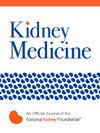Sepsis-Associated Acute Kidney Disease Incidence, Trajectory, and Outcomes
IF 3.2
Q1 UROLOGY & NEPHROLOGY
引用次数: 0
Abstract
Rationale & Objective
Systematic evaluation of the prognosis from sepsis-associated acute kidney disease (SA-AKD) using real-world data is limited. This study aimed to use data algorithms on the electronic health records to trace the SA-AKD trajectory from acute kidney injury (AKI) to chronic kidney disease (CKD).
Study Design
A retrospective cohort study.
Setting & Participants
Adult inpatients with first sepsis episode surviving 90 days after AKD in a quaternary referral medical center.
Exposure
We defined SA-AKD as having sustained ≥1.5-fold increased serum creatinine levels or initiating kidney replacement therapy after the SA-AKI, and we classified SA-AKD into recovery, relapse, and persistent SA-AKD subgroups.
Outcomes
All-cause mortality, kidney replacement therapy (KRT), de novo nondialysis dependent CKD (CKD-ND), and late-recovery AKD during 1-year follow-up.
Analytical Approach
A multivariable Cox proportional hazards models.
Results
Of 24,038 eligible inpatients with sepsis, 42.2% had SA-AKI, and 17.6% progressed to SA-AKD (43.6% recovery, 8.3% relapse, 32.2% persistent, and 15.9% unclassified). Compared with the recovery subgroup, the 1-year mortality risk for the relapse, persistent, and unclassified SA-AKD subgroups were 1.57 (adjusted hazard ratios [aHRs]; 95% CI, 1.22-2.01), 1.36 (1.13-1.63), and 0.65 (0.48-0.89), respectively. Risks of KRT initiation were 3.27 (2.14-4.98), 6.01 (4.41-8.19), and 0.98 (0.55-1.74), respectively, and corresponding aHRs for de novo CKD-ND were 3.84 (2.82-5.22), 3.35 (2.61-4.29), and 0.48 (0.30-0.77), respectively. Patients with relapse SA-AKD had a higher likelihood of late recovery (aHR, 3.62; 95% CI, 2.52-5.21) than the persistent SA-AKD.
Limitations
Selection bias and information bias could be present because of limiting population to sepsis survivors and because of no standardized follow-up protocol for kidney function.
Conclusions
SA-AKD without recovery is associated with increased and long-term risks of KRT initiation, mortality, and increased risk of de novo CKD-ND for patients initially free of CKD. Further studies are warranted for managing AKI to AKD to CKD in real-world settings.
Plain Language Summary
Systematic evaluation of the prognosis for sepsis-associated acute kidney injury (AKI) and sepsis-associated acute kidney disease (AKD) using real-world data remain limited. We applied standard definitions of sepsis and AKI/AKD and comprehensively profiled the AKI-AKD-chronic kidney disease (CKD) trajectory among sepsis survivors in a large, longitudinal hospital-based cohort. Our study showed that sepsis-associated AKD without recovery is associated with elevated and long-term risks of progressing to kidney replacement therapy, mortality, and new onset of CKD. These findings advocate for a paradigm shift toward digital therapies for managing the transition from AKI to AKD to CKD among patients with sepsis.
脓毒症相关急性肾脏疾病的发病率、发展轨迹和结局
基本原理及目的利用真实数据系统评价脓毒症相关急性肾病(SA-AKD)的预后是有限的。本研究旨在利用电子健康记录上的数据算法来追踪从急性肾损伤(AKI)到慢性肾脏疾病(CKD)的SA-AKD轨迹。研究设计:回顾性队列研究。设置,参与者:在一家四级转诊医疗中心,首次脓毒症发作的成年住院患者在AKD后存活90天。我们将SA-AKD定义为在SA-AKI后血清肌酐水平持续升高≥1.5倍或开始肾脏替代治疗,并将SA-AKD分为恢复期、复发期和持续性SA-AKD亚组。结果:1年随访期间,全因死亡率、肾脏替代治疗(KRT)、新发非透析依赖性CKD (CKD- nd)和晚期恢复性AKD。分析方法:多变量Cox比例风险模型。结果24,038例符合条件的脓毒症住院患者中,42.2%患有SA-AKI, 17.6%进展为SA-AKD(43.6%恢复,8.3%复发,32.2%持续,15.9%未分类)。与恢复亚组相比,复发、持续性和未分类SA-AKD亚组的1年死亡风险为1.57(校正风险比[aHRs];95% CI分别为1.22-2.01)、1.36(1.13-1.63)和0.65(0.48-0.89)。KRT启动的风险分别为3.27(2.14-4.98)、6.01(4.41-8.19)和0.98 (0.55-1.74),CKD-ND的相应ahr分别为3.84(2.82-5.22)、3.35(2.61-4.29)和0.48(0.30-0.77)。复发的SA-AKD患者晚期恢复的可能性更高(aHR, 3.62;95% CI, 2.52-5.21)优于持续性SA-AKD。局限性:选择偏倚和信息偏倚可能存在,因为脓毒症幸存者的人群有限,也因为肾功能没有标准化的随访方案。结论:未恢复的sa - akd与KRT启动、死亡率和最初无CKD的患者新发CKD- nd的风险增加和长期风险相关。在现实环境中,AKI到AKD再到CKD的管理需要进一步的研究。使用真实世界数据对败血症相关急性肾损伤(AKI)和败血症相关急性肾脏疾病(AKD)的预后进行系统评估仍然有限。我们应用了脓毒症和AKI/AKD的标准定义,并在一个大型的纵向医院队列中全面描述了脓毒症幸存者的AKI-AKD-慢性肾脏疾病(CKD)轨迹。我们的研究表明,脓毒症相关的AKD未恢复与进展为肾脏替代治疗、死亡率和新发CKD的风险升高和长期风险相关。这些发现提倡在脓毒症患者中进行从AKI到AKD再到CKD的数字化治疗。
本文章由计算机程序翻译,如有差异,请以英文原文为准。
求助全文
约1分钟内获得全文
求助全文

 求助内容:
求助内容: 应助结果提醒方式:
应助结果提醒方式:


